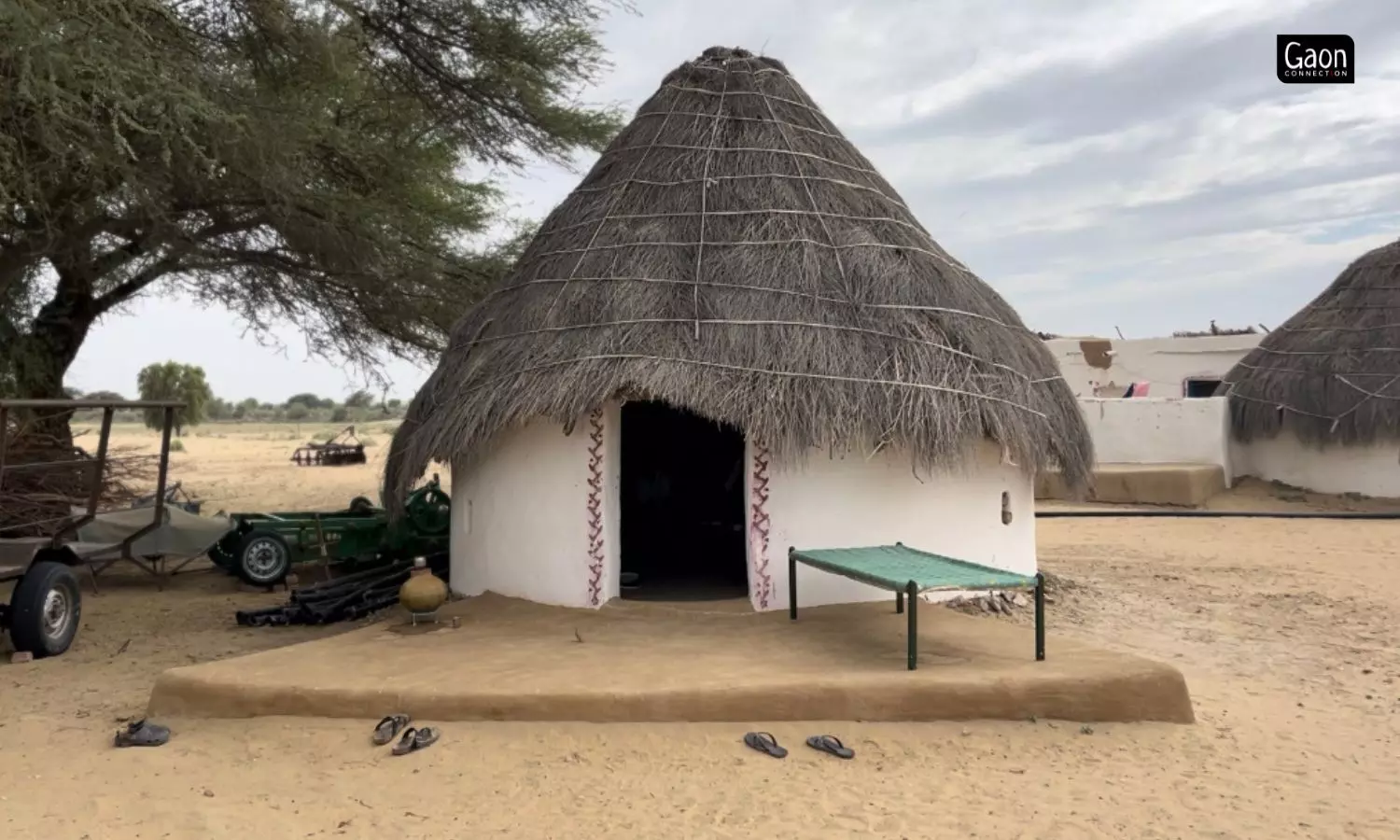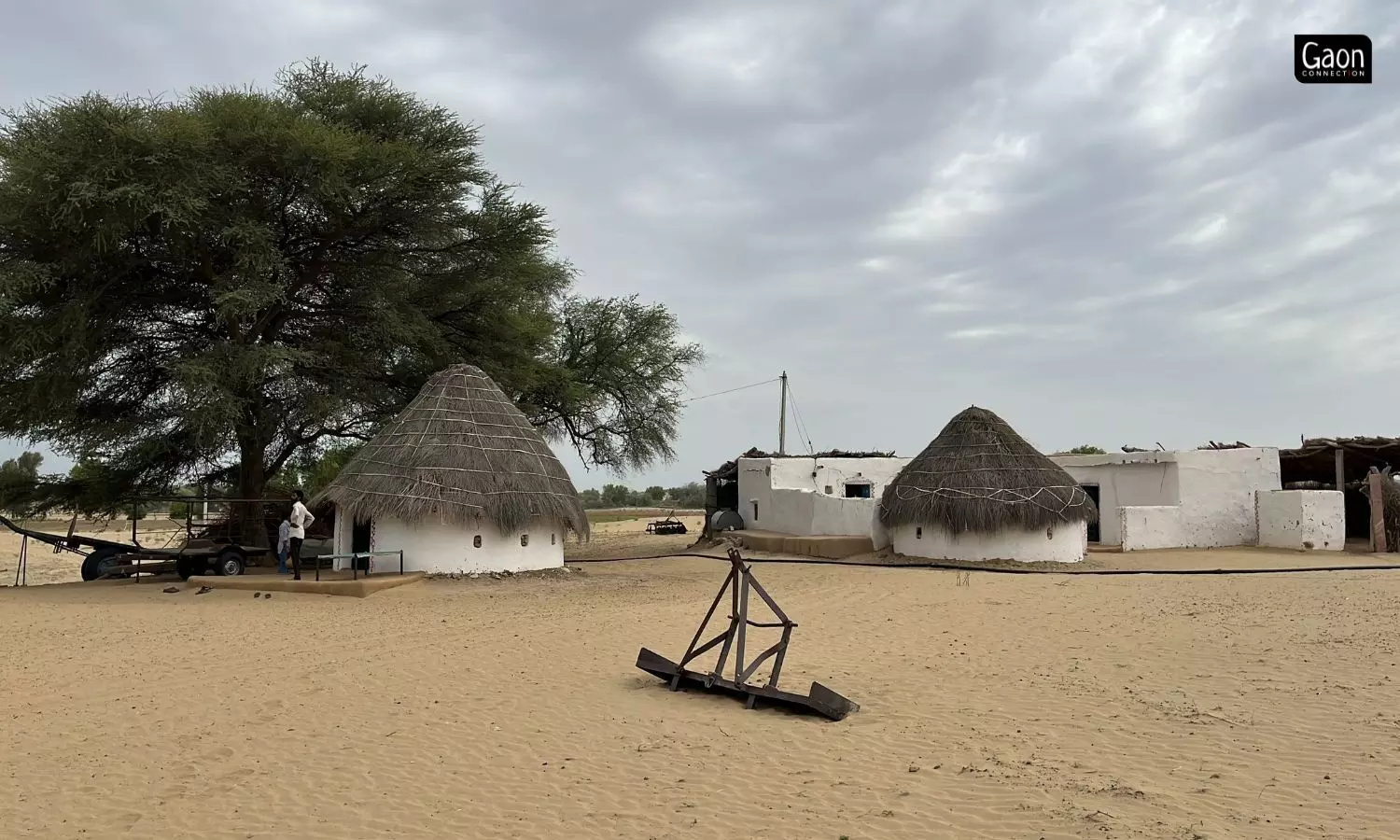Bikaner, Rajasthan
It is barely dawn and Mahaveer Singh is already at work on his farm where he grows vegetables, fodder and lemons in four and half acres.
“I always start early and try to finish my work by eleven in the morning after which I go indoors,” the 55-year-old farmer in Bajju, Bikaner district of Rajasthan , told Gaon Connection. That is to escape the blistering heat of the Thar desert where summer temperatures often cross 47-48 degree Celsius.
For centuries, communities have been living in the inhospitable terrain of the vast desert in Rajasthan and have evolved their lives and lifestyle, including construction of their huts, around it.
Mahaveer’s home, where he lives by himself, is thatched with kheep, a locally grown grass variety. It is a cool haven where he stays until the evening when the sun goes down. This is how, the farmer said, his ancestors have survived in the registaan (desert). While the traditional huts have no electricity, Mahaveer’s hut that was provided to him by a non-profit has solar panels that allow him to use one fan and one bulb.
Kheep (Leptadenia pyrotechnica) is used widely by communities for whom the desert is home. The plant has the ability to withstand rising temperatures, changing climates, and the intensifying frequency of droughts. With its long roots it can thrive in extreme conditions and it plays a vital role in stabilising the fragile desert ecosystem.
Also Read: The desert coolers of Rajasthan
The walls of Mahaveer’s humble hut are made up of intricately woven slender branches, bound together by ropes. The thatch, the walls and the ropes are all made of kheep grass that grows in the water-scarce desert environment. Outside his home are shrubs, some of which closely resemble the thatched hut.
“The walls of my hut are plastered with a paste of cow dung, and the temperature indoors remains surprisingly and refreshingly cool, even during the scorching noon hours,” explained Mahaveer.
Kheep huts giving way to concrete houses
In Bikaner, Rajasthan, in the village of Bursalpur, close to the Indo-Pakistan border, lives Kasturi Devi. “When the temperatures soar and it gets impossibly hot, I seek refuge in a kheep hut that still stands just outside my concrete home” the 65-year-old told Gaon Connection.
Kasturi has lived in a kheep hut all her life until about eight years ago her children decided that a concrete structure was more ‘prestigious’ to live in.
Thatched kheep huts are still visible in the hamlets that dot the desert terrain for their endurance as well as the protection they offer from the heat. But, clearly, their numbers are dwindling as concrete structures take over.

For centuries, communities have been living in the inhospitable terrain of the vast desert in Rajasthan and have evolved their lives and lifestyle, including construction of their huts, around it. Photo by Twarita Chouhan.
It is a pity that this traditional building practice is disappearing, said Manu Sharma, director (Innovations), Desert Resource Centre, Bikaner. “Kheep is a breathable fibre and it dilutes and can potentially eliminate toxic compounds. It can contribute to a healthier environment. It allows airflow and circulation and delivers cleaner and breathable air to the environment,” Sharma told Gaon Connection.
It also removes airborne pollutants, unpleasant odours, and other volatile organic compounds within indoor spaces, he added.
Also Read: In these villages in Jaisalmer, every house has a traditional ‘beri’ to collect rainwater
Dying traditional knowledge
“A few years ago the village had almost all kheep-thatched homes. The men had the skill and knowledge about constructing these huts. The women gathered the kheep, and even the children would participate in the building activity, and learn the art of kheep thatch making along the way,” Kasturi Devi reminiscenced.
The kheep roof was overhauled every two years. Old and weak grass was removed and replaced with fresh kheep. This process was performed before the onset of rains.
The roofs were constructed in such a way that it ensured that no water entered even when it rained. The kheep also regulated moisture levels within the huts.
“Not too many people want the kheep roofs nowadays,” Palaram, an artisan from Alsu in Churu district of Rajasthan, told Goan connection. Palaram comes from many generations of kheep-thatch-makers.

The roofs were constructed in such a way that it ensured that no water entered even when it rained. The kheep also regulated moisture levels within the huts. Photo by Twarita Chouhan.
“The changing lifestyle of people and the scarcity of kheep are responsible for this. More and more land is being acquired as real estate. Concrete homes are becoming the norm, he said.
“My son is not following in my footsteps. He does not want to pursue the traditional family occupation and has instead chosen to become a mason,” Palaram said.
Also Read: A Date With Israel: Farmers in Jaisalmer experiment with dates
Disappearing kheep grass
The kheep is dwindling in use in the deserts. One of the reasons is that it is getting increasingly difficult to find it.
This is worrying to many of the desert inhabitants. “I own 400 camels and a big part of their fodder is kheep,” Gaina Ram, a pastoralist, from Grandi, in Bikaner district of Rajasthan told Gaon Connection.
“Acquisition of land for agriculture, industrialisation, and mining has left no space for fodder to grow. I grew up under a thatched roof made of kheep, ” said the 50-year-old.
Kheep that is used by desert communities has the ability to withstand rising temperatures, changing climates, and the frightening frequency of droughts. With its long roots and ability to thrive in extreme conditions, it plays a vital role in stabilising the fragile desert ecosystem.
Twarita Chouhan is a fellow of the Arvind Ojha Deserts Fellowship. She is living in the Thar desert and learning about the land, and life of local communities there.


















